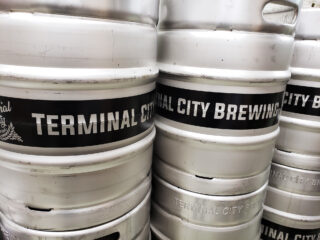Join the Terminal City Brewing Mailing List!
Enjoy savings, advance notice on new products and exclusive subscriber-only specials as well as joining the Terminal City Brewing Loyalty Points Program!

$4.99 – $19.99
One Step No Rinse Cleaner is an easy to use, safe, no-rinse cleanser that quickly breaks up light to medium soils on wine (and beer) making equipment, including all plastics, glass and metals.
One Step No Rinse Cleaner is made from Aseptox. Other powdered cleansers require rinsing due to their alkaline nature. Aseptox uses active oxygen to do its work.
Simply mix ¾ teaspoon of One Step No Rinse Cleaner per litre of (1 tablespoon per US-gallon) of cold or warm water and dissolve. Rinse or soak equipment and bottles with the Aseptox solution and use. For best results, ensure that you have a 30 second contact time with the Aseptox solution.
Aseptox works by producing hydrogen peroxide in solution. Peroxides are degraded by organic soils, light, and heat. In a closed, dark, clean container kept in a cool place the solution will last up to 1 week.
Aseptox consists of oxygen bonded to mineral crystals. When added to water, the crystals dissolve and release oxygen to form hydrogen peroxide. After hydrogen peroxide does its work it degrades into oxygen and water, leaving only the minerals behind. Those minerals are naturally occurring compounds in the environment-in fact, you probably have appreciable amounts of them in your tap water.
There is a very low level of solid material in an Aseptox solution (¾ teaspoon per litre is not much!) In addition, the solution drains very easily and leaves very little solution behind. Even those solids that may be left are the same types of minerals which you would be leaving behind if you rinsed with tap water.
“Sanitizer” is a legal term defined by the CFIA (Canadian Food Inspection Agency). In order for a product to be called a sanitizer on its packaging, that product must be approved, assigned a registration number, and have an open file maintained with the CFIA. Because this requires an enormous amount of capital investment the manufacturer chooses not to call their product a sanitizer.
Many people use Aseptox for this purpose, but final rinsing with metabisulphite is an excellent idea-especially if you’re storing the Aseptox-cleaned equipment for any time before use.